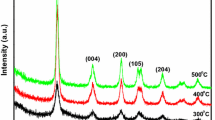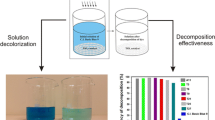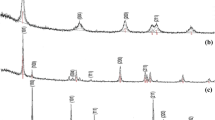Abstract
We have prepared TiO2 nanoparticles by the hydrolysis of titanium tetraisopropoxide (TTIP) using HNO3 as a peptizing agent in the hydrothermal method. The physical properties of nanosized TiO2 have been investigated by TEM, XRD and FT-IR. The photocatalytic degradation of orange II has been studied by using a batch reactor in the presence of UV light. When the molar ratio of HNO3/TTIP was 1.0, the rutile phase appeared on the titania and the photocatalytic activity decreased with an increase of HNO3 concentration. The crystallite size of the anatase phase increased from 6.6 to 24.2 nm as the calcination temperature increased from 300 °C to 600 °C. The highest activity on the photocatalytic decomposition of orange II was obtained with titania particles dried at 105 °C without a calcination and the photocatalytic activity decreased with increasing the calcination temperature. In addition, the titania particles prepared at 180 °C showed the highest activity on the photocatalytic decomposition of orange II.
Similar content being viewed by others
References
Chai, Y. S., Lee, J.C. and Kim, B.W., “Photocatalytic Disinfection of E. coli in a Suspended TiO2/UV Reactor,”Korean J. Chem. Eng.,17, 633 (2000).
Cullity, B. D.,Elements of X-Ray Diffraction, 2nd edn., Addison-Wesley, Reading, MA, 102 (1978).
Fujishima, A., Hashimoto, K. and Watanabe, T., “TiO2 Photocatalysis,” 124, Inc, Tokyo, 124 (1999).
Gopal, M., Moberly Chan, W. J. and Jonghe, L. C., “Room Temperature Synthesis of Crystalline Metal Oxides,”J. Mater. Sci.,32, 6001 (1997).
Hong, S. S., Lim, C.G., Lee, G. D., Lim, K. T. and Ahn, B. H., “Photocatalytic Degradation of Phenol over TiO2 Prepared by Sol-gel Method,”J. Ind. & Eng. Chem.,7, 99 (2001).
Hong, S. S., Lee, M. S. and Lee, G. D., “Photocatalytic Decomposition of p-Nitrophenol over Titanium Dioxide Prepared by Reverse Microemulsion Method Using Nonionic Surfactants with Different Hydrophilic Group,”React. Kinet. & Catal. Lett.,80, 145 (2003).
Lee, G. D., Jung, S.K., Jeong, Y. J., Park, J. H., Suh, C. S., Ahn, B. H. and Hong, S. S., “Photocatalytic Decomposition of 4-Nitrophenol over Titanium Silicalite (TS-1) Using Hydrogen Peroxide as an Oxidant,”J. Ind. & Eng. Chem.,8(1), 22 (2002).
Lim, K.T., Hwang, H. S., Lee, M. S., Lee, G. D., Hong, S. S. and Johnston, K. P., “Formation of TiO2 Nanoparticles in Water-in-CO2 Microemulsions,”Chem. Commun.,14, 1528 (2002).
Mu, Y., Yu, H.Q., Zheng, J.C. and Zhang, S. J., “TiO2-Mediated Photocatalytic Degradation of Orange II with the Presence of Mn2+ in Solution,”J. Photochem. & Photobio., A: Chem.,163, 311 (2004).
Nam, W. S. and Han, G.Y., “A Photocatalytic Performance of TiO2 Photocatalyst Prepared by the Hydrothermal Method,”Korean J. Chem. Eng.,20, 180 (2003).
Pecchi, G., Reyes, P., Sanhueza, P. and Villasenor, J., “Photocatalytic Degradation of Pentachlorophenol on TiO2 Sol-Gel Catalysts,”Chemosphere,43, 141 (2001).
Reddy, K.M., Reddy, C.V.G. and Manorama, S.V., “Preparation, Characterization, and Spectral Studies on Nanocrystalline Anatase TiO2,”J. Solid State Chem.,158, 180 (2001).
Ryu, Y. B., Lee, M. S., Park, S. S., Lee, G. D. and Hong, S. S., “Effect of Synthesis Temperature on Preparation of Titanium Dioxides Using Hydrothermal Method and Their Photocatalytic Activity,”React. Kin. & Catal. Lett., in press.
Turchi, C. S. and Ollis, D. F., “Photocatalytic Degradation of Organic Water Contaminants: Mechanisms Involving Hydroxyl Radical Attack,”J. Catal.,122, 178 (1990).
Wang, C. and Ying, J.Y., “Sol-Gel Synthesis and Hydrothermal Processing of Anatase and Rutile Titania Nanocrystals,”Chem. Mater.,11, 3113 (1999).
Wold, A., “Photocatalytic Properties of Titanium Dioxide (TiO2),”Chem. Mater.,5, 280 (1993).
Yang, J., Mei, S. and Ferreira, J.M. F., “Hydrothermal Synthesis of TiO2 Nanopowders from Tetraalkylammonium Hydroxide Peptized Sols,”Mater. Sci. & Eng., C,15, 183 (2001).
Author information
Authors and Affiliations
Corresponding author
Rights and permissions
About this article
Cite this article
Kim, J.H., Noh, B.H., Lee, GD. et al. Hydrothermal synthesis of titanium dioxide using acidic peptizing agents and their photocatalytic activity. Korean J. Chem. Eng. 22, 370–374 (2005). https://doi.org/10.1007/BF02719413
Received:
Accepted:
Issue Date:
DOI: https://doi.org/10.1007/BF02719413




